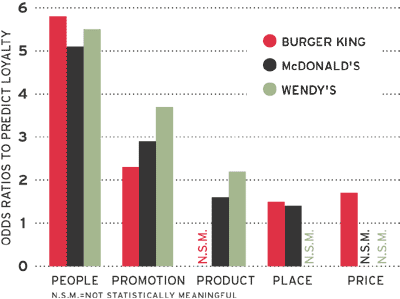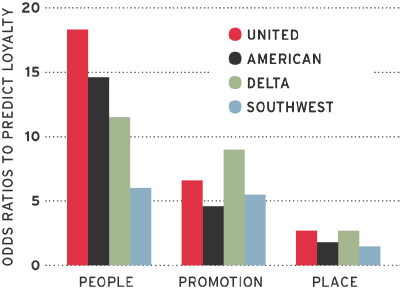The name of the game for any brand manager today is romancing the customer with a view to establishing a long-term relationship. Relationship, not product, is key. Relationships bind, have duration, foster loyalty, create repeat sales. The sum total of millions of relationships is a priceless asset that never appears on the brand balance sheet, but given the tremendous cost of customer acquisition, it is a foundation of profitability. One-night stands are expensive; companies need to marry customers, preferably for life.
Marketing 101 reduces the main determinants of customer loyalty to the familiar Four Ps: Product, Place, Promotion and Price. These are all critical factors, but marketing orthodoxy is myopic, for reasons that are often lodged right in the structure and culture of corporations. The result is that a fifth P is typically left out of the reckoning: People. Specifically, I mean the people who actually deal with the customer during any part of the transaction. The delivery of the brand promise often happens by human agency at the point of sale and proceeds through service, complaint and resale. Yet marketers, who have the bottom-line responsibility for brand health, rarely focus on the Fifth P.
Why this neglect? In part it's because this Fifth P manifests itself far from marketing headquarters, and a corporation's customer-facing employees are not often the responsibility of brand managers but are instead relegated to what is usually called human resources. HR has little to do with brand and, in my experience, brand managers often have nothing to do with HR, which they probably feel is charged to set up interviews with MBAs, track vacation time and hire file clerks. The result is that neither of these two critical constituencies see themselves pursuing the same brand-building and customer-relationship-building goal.
Thus the Fifth P often falls between the cracks. Not only is organizational compartmentalization to blame, but so is the way companies measure success. It is often not possible to reliably count which of a company's annual sales are repeats and which are new. Then too it is obviously difficult to disaggregate all the ingredients of loyalty, including product quality, image, reputation, design and service. Because of this we feel many companies underestimate the degree to which customer loyalty is a significant driver of sales and other important outcomes.
The price of neglect
The cost of neglect of the customer experience is significant,
according to Â鶹´«Ã½AV Organization surveys of more than 6,000
customers of familiar brands in six businesses: automobiles, fast
food, consumer banking, long-distance telephone services, retail
electronics and airlines. (See graphics below for specific data on
airlines and fast food.)
Between November 1999 and January 2000, regular or former customers were identified, asked about their reactions to each brand's marketing efforts and questioned about their repurchase considerations and plans. Our findings strongly suggest that employees who deal with customers not only represent the brand but, in the perceptions of customers, become the brand. Employees have the power, by dint of actual service and sometimes by mere attitude and body language, to add to or subtract from brand value. Attention must be paid to the subtraction side, because customers have the memory of elephants when it comes to disappointments and unmet expectations. Positive memories may fade, but resentments can last a lifetime.
Consider the case of long-distance phone companies. Current or former customers of AT&T, MCI and Sprint who feel that customer service representatives are not helpful are, respectively, 6.6, 5.7 and 2.5 times more likely to say that they won't consider this provider in the future. Now consider another contributor to loyalty: the quality of technical service. AT&T and MCI customers who have experienced poor service reliability and service quality in the past are only 1.9 and 2.4 times more likely to say that they won't consider this carrier in the future. Remember that interaction with employees need not be in person to make its impact; it can happen over the phone or through the mail and still affect the relationship. The moral is clear: A dollar spent improving the people factor is probably a better investment than a dollar spent improving technical quality.
Many companies' primary brand builders often earn a buck or two over minimum wage, but the problem is selection, management and training; employees are rarely selected for their brand-building potential, and new hires are often poorly trained in brand-enhancing behaviors. A fast-food chain might overemphasize price cuts, speed or menu changes and undervalue customer contact as the source of repeat business.
Adding a fifth P may sound easy, but organizational rigidity stands in the way. The CEO must demand that top-level marketing and human resource teams share insights and develop a permanent program that accounts for the employee in the brand equation.
|
|
 |
|
|
|
|
 |
|
|